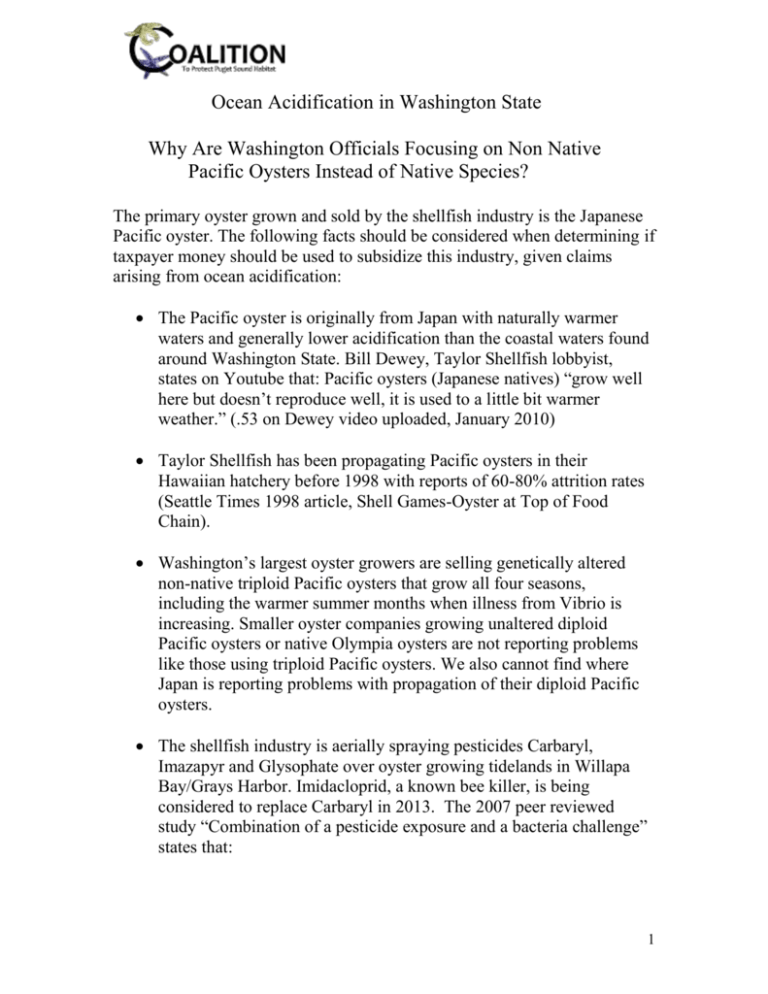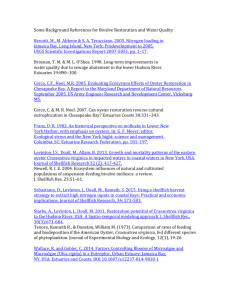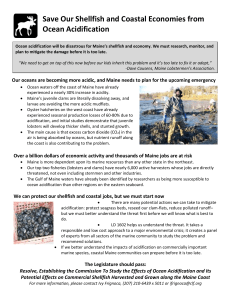Ocean Acidification in Washington State
advertisement

Ocean Acidification in Washington State Why Are Washington Officials Focusing on Non Native Pacific Oysters Instead of Native Species? The primary oyster grown and sold by the shellfish industry is the Japanese Pacific oyster. The following facts should be considered when determining if taxpayer money should be used to subsidize this industry, given claims arising from ocean acidification: The Pacific oyster is originally from Japan with naturally warmer waters and generally lower acidification than the coastal waters found around Washington State. Bill Dewey, Taylor Shellfish lobbyist, states on Youtube that: Pacific oysters (Japanese natives) “grow well here but doesn’t reproduce well, it is used to a little bit warmer weather.” (.53 on Dewey video uploaded, January 2010) Taylor Shellfish has been propagating Pacific oysters in their Hawaiian hatchery before 1998 with reports of 60-80% attrition rates (Seattle Times 1998 article, Shell Games-Oyster at Top of Food Chain). Washington’s largest oyster growers are selling genetically altered non-native triploid Pacific oysters that grow all four seasons, including the warmer summer months when illness from Vibrio is increasing. Smaller oyster companies growing unaltered diploid Pacific oysters or native Olympia oysters are not reporting problems like those using triploid Pacific oysters. We also cannot find where Japan is reporting problems with propagation of their diploid Pacific oysters. The shellfish industry is aerially spraying pesticides Carbaryl, Imazapyr and Glysophate over oyster growing tidelands in Willapa Bay/Grays Harbor. Imidacloprid, a known bee killer, is being considered to replace Carbaryl in 2013. The 2007 peer reviewed study “Combination of a pesticide exposure and a bacteria challenge” states that: 1 “Oyster mortality was higher in pesticide-treated oysters compared to untreated oysters after the bacterial challenge. Gene expression was upregulated in pesticide-treated oysters compared to untreated oysters after the bacterial challenge. We hypothesize that gene over-expression due to an interaction between pesticides and bacteria could lead to an injury of host tissues, resulting in higher mortality rates.” Combination of a pesticide exposure and a bateria challenge. In vivo effects on immune response of Pacific Oyster, (2007), Gagnaire, Gay, Hurvet, Daniel, Saulnier, Renault Richard Feely, a scientist with the National Oceanic and Atmospheric Administration in Seattle and an acidification expert, said the governor was probably accurate when it comes to the Pacific oyster, but the science isn’t clear yet on other species such as crabs.” Climate Change A Top Concern for Governor Inslee, Seattle Times Article-March 18, 2013 The February 13, 2013 Seattle Times reported that: Recent Coastal Razor Clam Digs Were Excellent and Participation Was Largest of Winter Season (excerpted below) The shellfish industry continues to demand expansion despite the declining number of calcifying agents necessary to produce shells for the existing marine life, much less millions more introduced shellfish. Shellfish industry efforts to eradicate Zostera japonica (eelgrass) in all Washington waters, which serves as a carbon sink, is contrary to reducing ocean acidification effects. The following information was sent to us that is relevant to this issue: The first Seattle Times article below indicates that Washington Governor Chris Gregoire convened a panel of scientists and policy experts on ocean acidification that reported in November that there are ominous signals coming from the ecosystem on acidification, as ominous as anything coming from climate change, and that the “corrosive” water has had a dramatic effect on clams and oysters and could potentially affect the broader marine food web. Former NOAA administrator Jane Lubchenko said that this acidification report draws attention to a problem that exists internationally and that ocean acidification has hit the state of Washington particularly hard. Governor Gregoire’s ocean acidification report and Jane Lubchenko have suggested that Washington’s clams and other shellfish have been hit particularly hard by ocean acidification, but evidence of the negative effects of ocean acidification on Washington’s razor clams is not apparent in the second Seattle Times article below. Recent Coastal Razor Clam Digs Were Excellent and Participation Was Largest of Winter Season 2 indicates that the recent razor clam digs were not only stellar, but also generated one of the largest clam digger turnouts this winter. Note Washington coastal shellfish manager Dan Ayres’ positive statements from this February 13 article that, "The big clams are mixed with some smaller ones, but from a biological standpoint this is great news." and "The clams are also in good condition. There is a lot of feed on the beaches. I believe this is why they were showing so well on the surface of the sand as they were actively feeding." Washington Panel Presses for Action on Ocean Acidity, in the November 27, 2012 Seattle Times link at http://seattletimes.com/html/localnews/2019775352_apwaoceanacidification4thldwrit ethru.html, included the following statements, “Rising acidity levels in the oceans pose a serious threat to shellfish and other marine life, and tackling that problem in Washington state will require reducing carbon dioxide emissions, keeping polluted runoff out of marine waters, and increasing monitoring at hatcheries, a group of experts said Tuesday. The panel of scientists and policy experts convened by Gov. Chris Gregoire recommended dozens of actions to combat changes to ocean chemistry detected several years ago when oyster larvae in Pacific Northwest hatcheries began dying in large numbers. "There are ominous signals coming from the ecosystem on this issue, as ominous as anything coming from climate change," said Jay Manning, former state ecology director who headed the panel with former Environmental Protection Agency administrator Bill Ruckelshaus.”-and“Jane Lubchenco, administrator of the National Oceanic and Atmospheric Administration, said the report draws attention to a problem that exists internationally but has hit particularly hard in the state of Washington. Acidification is caused when oceans absorb human-generated carbon dioxide, mostly from the atmosphere and also from nutrient runoff and other sources. Studies have shown that corrosive water has a dramatic effect on oysters, clams, and corals, and could potentially affect the broader marine food web. Washington state is the nation's top producer of farmed shellfish. The problem affects the industry along with consumers and anyone who has ever dug up razor clams or picked oysters on the coast, Manning said.” Recent Coastal Razor Clam Digs Were Excellent and Participation Was Largest of Winter Season Recent Coastal Razor Clam Digs Were Excellent and Participation Was Largest of Winter Season, in the February 13 Seattle Times link at http://seattletimes.com/html/reeltimenorthwest/2020352357_recent_coastal_razor_cl am_digs_1.html, begins with the following statements. 3 “The recent coastal razor clam digs were not only stellar, but also generated one of the largest turnouts this winter. "It was off the charts digging (Feb. 7-12), and we had a total of 37,600 diggers coastwide with 14.95 clams per person (the first 15 dug is a daily limit)," said Dan Ayres, the head state Fish and Wildlife coastal shellfish manager. A total of 561,000 clams were dug, and was by far the biggest series this year as far as turnout goes. The October season opener lured 19,000 diggers and 22,000 diggers came out on New Years. "On Saturday alone we saw just shy of 23,000 people out, and that is one of the bigger single days we've had a in a longtime," Ayres said. "The size of the clams weren't too bad." At Long Beach razor clams averaged 3.9 inches; Twin Harbors it was 4.4 inches; Copalis it was 4.6 inches; and Mocrocks it was 4.5 inches. "The big clams are mixed with some smaller ones, but from a biological standpoint this is great news," Ayres said. "The clams are also in good condition. There is a lot of feed on the beaches. I believe this is why they were showing so well on the surface of the sand as they were actively feeding." "People were reporting a lot of brown stuff on beaches, and I had to tell them that it is diatoms (which the clams are feeding on)," Ayres said. "They need that, and a happy ocean equals happy clams." Ayres said his family got done digging at Twin Harbors before it got dark and just prior to low tide. "It was daylight digging and it was great to see everybody getting limits," Ayres said. "I like happy clam diggers." March 2013 4








